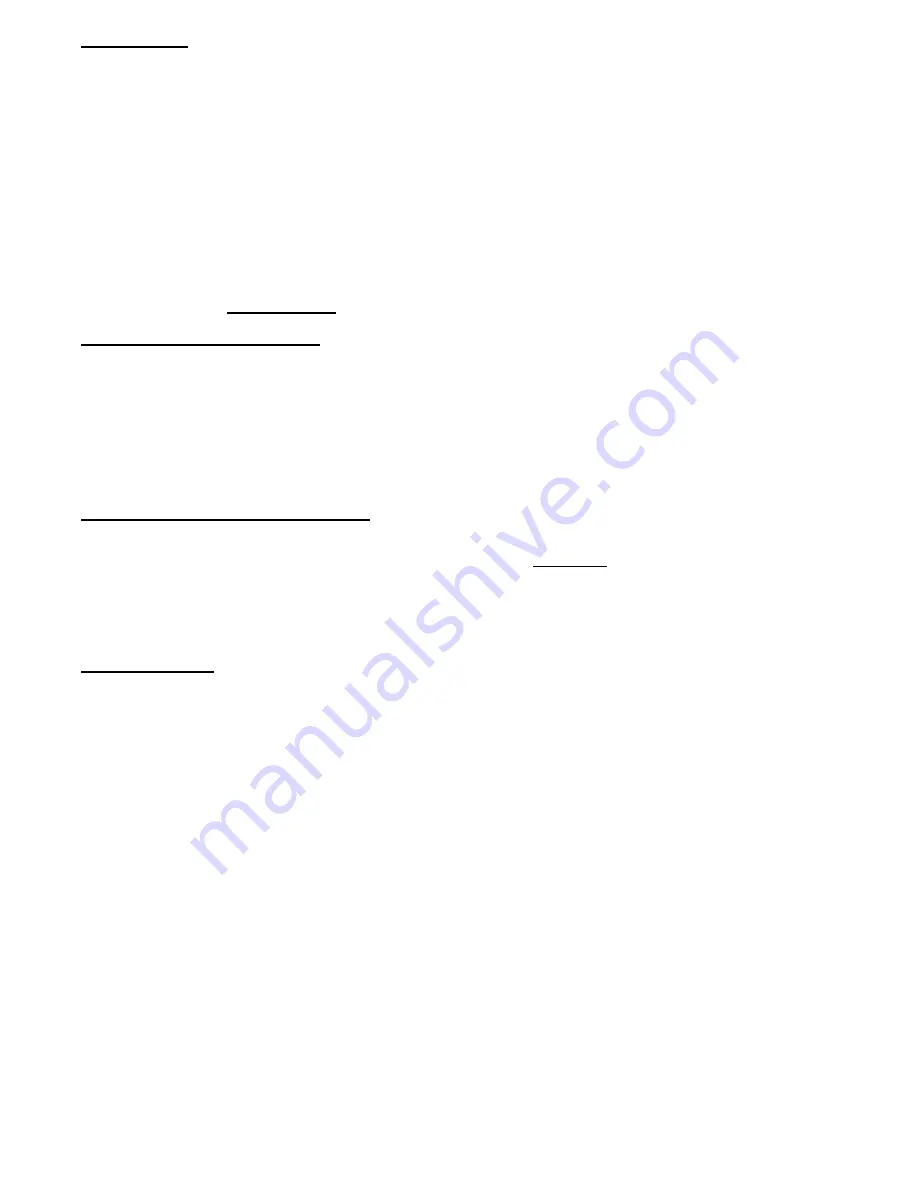
OPERATION
The best way to get acquainted with how your winch operates is to make test runs before you actually use it.
Plan your test in advance. Remember, you hear your winch, as well as see it operate. Get to recognize the
sounds of a light steady pull, a heavy pull, and sounds caused by load jerking or shifting. Avoid conditions
where load shifts or jerks occur, as they may indicate a dangerous situation.
The uneven spooling of cable, while pulling a load, is not a problem, unless there is a cable pileup on one end of
drum. If this happens, reverse the winch to relieve the load and move your anchor point further to the center of
the vehicle. After the job is done you can unspool and rewind for a neat lay of the cable.
When pulling a heavy load place a blanket, jacket or tarpaulin over the cable about five or six feet behind the
hook. In the event of a broken cable, this will slow the snap back of the cable and could prevent serious injury.
The winch clutch allows rapid unspooling of the cable, from cable drum, for hooking onto the load. The clutch is
operated by the clutch shifter lever or air shifter.
WARNING: DO NOT DISENGAGE CLUTCH UNDER LOAD.
MANUAL CLUTCH SHIFTER
(Refer to page 14)
TO DISENGAGE CLUTCH: Run the winch in the reverse (reel out) direction until load is off the cable. Pull handle
out and rotate 90
o
. With handle in the "DISENGAGED" position cable may now be free-spooled from drum.
TO ENGAGE CLUTCH: Pull handle out, rotate 90
o
and release handle. Run the winch in reverse until the clutch
handle snaps fully into the "ENGAGED" position.
DO NOT
attempt to pull a load unless the handle is fully at the
"ENGAGED" position. If manual shift indicator light is present, the green light is lit when clutch is fully
"ENGAGED".
DO NOT
attempt to pull a load unless the green light is lit. To hookup light to the vehicle electrical
system refer to the Electrical Schematic on page 15.
AIR CYLINDER CLUTCH SHIFTER
(Refer to page 15)
TO DISENGAGE CLUTCH: Run the winch in the reverse (reel out) direction until load is off the cable. Apply air
pressure to the .125-27 NPT port: 80 PSI (min.), 150 PSI (max.).
CAUTION: Pressure must not exceed 150
PSI.
TO ENGAGE CLUTCH: Remove air pressure form the cylinder (a return spring engages the plunger). Run winch
in reverse until the clutch engagement indicator light (green light) is lit.
DO NOT
attempt to pull a load unless the
green light is lit. To hookup light to the vehicle electrical system refer to the Electrical Schematic on page 15.
MAINTENANCE
1.
Inspect the cable for damage and lubricate frequently. If the cable becomes frayed with broken strands, re-
place immediately. Cable and hook assembly (100' lg. cable) P/N 524118 ("Y" drum) or (150' lg. cable) P/N
524119 ("STD" drum) may be purchased from a Ramsey distributor.
2.
Check that the clutch is fully engaging. See OPERATION instructions, above,for the appropriate clutch shifter.
FOR MANUAL CLUTCH ONLY: Monthly disengage clutch, put several drops of oil on the shaft and work
clutch IN and OUT several times to lubricate inside of clutch cylinder
3.
Check brake for drift. Refer to page 7.
4.
Check oil level of winch brake housing every month. Remove oil level plug (refer to pg.13). Oil level should
be kept up to oil level hole (plus or minus 1/8"). Replace oil annually or more often if winch is used frequently.
Use 1/2 pint of Mobilfluid 424, Phillips HG Fluid, Texaco TDH, Shell Oil Co. Donax TD high performance trac-
tor transmission fluid or equivalent, and for quietest operation, add 1/4 fl. oz. of an oil additive (available from
the factory).
5.
Check to see that drum cable does not overrun (BIRDNEST) when freespooling. Refer to page 3.
6.
Replace drum bushings and seals when seals begin to seep grease. Refer to OVERHAUL INSTRUCTIONS,
page 8. Add additional lubricant, Mobilith SHC 007, to gears if required.
5
Summary of Contents for RPH 8000
Page 1: ......
Page 2: ......
Page 3: ......
Page 4: ......
Page 5: ......
Page 6: ......
Page 9: ......
Page 11: ......
Page 12: ......
Page 13: ......
Page 14: ......
Page 16: ......
Page 17: ......
Page 19: ...17...
Page 21: ...19...
Page 23: ...21...
Page 25: ...23...
Page 26: ...NOTES...
Page 27: ...NOTES...




























